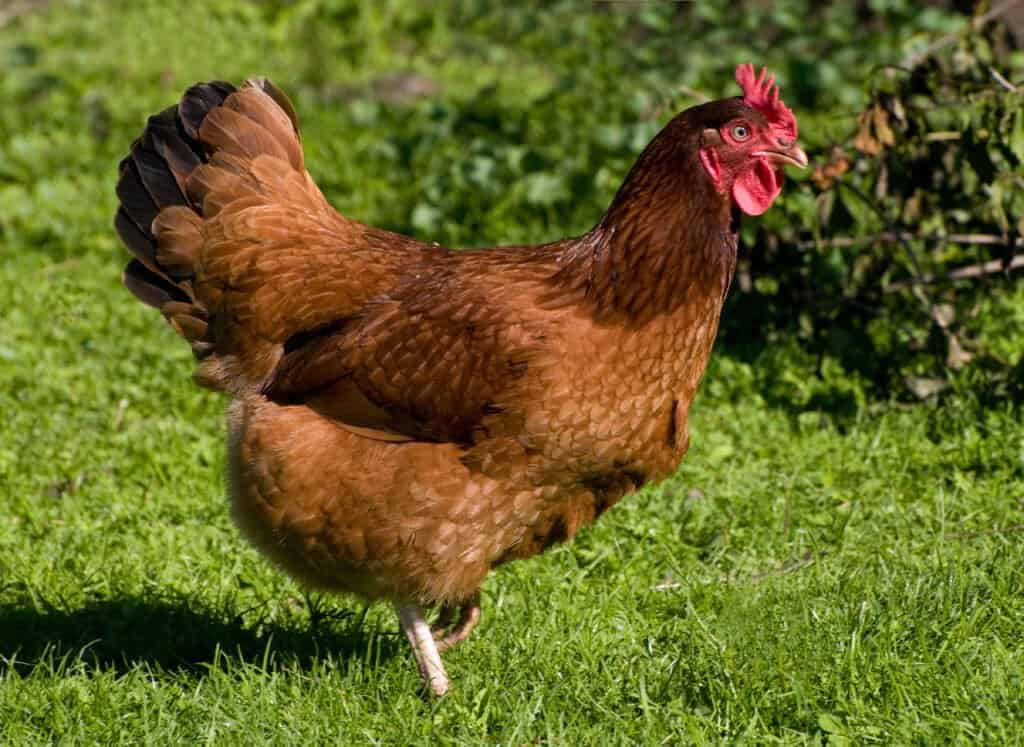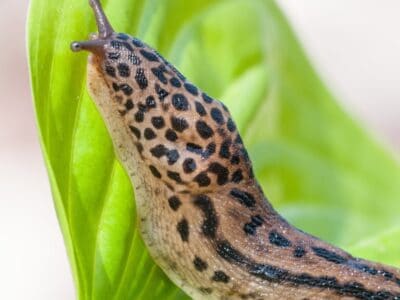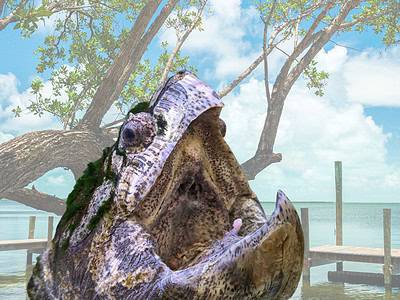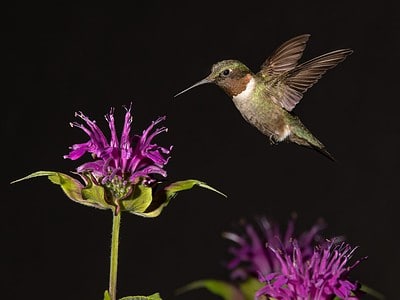Rhode Island Red Chicken
Gallus gallus domesticus
Rhode Island Reds thrive in colder climates but are prone to frostbite, especially on their combs. But, if you smear some petroleum jelly on their combs, it can prevent frostbite
Advertisement
Rhode Island Red Chicken Scientific Classification
- Kingdom
- Animalia
- Phylum
- Chordata
- Class
- Aves
- Order
- Galliformes
- Family
- Phasianidae
- Genus
- Gallus
- Scientific Name
- Gallus gallus domesticus
Read our Complete Guide to Classification of Animals.
Rhode Island Red Chicken Conservation Status
Rhode Island Red Chicken Facts
- Prey
- Insects, worms, and rodents
- Name Of Young
- Chicks
- Group Behavior
- Group
- Fun Fact
- Rhode Island Reds thrive in colder climates but are prone to frostbite, especially on their combs. But, if you smear some petroleum jelly on their combs, it can prevent frostbite
- Most Distinctive Feature
- Rust coloring
- Incubation Period
- 21 days
- Predators
- Mountain lions, leopards, caracals, foxes, weasels, birds of prey, and minks
- Diet
- Omnivore
- Lifestyle
- Diurnal
- Common Name
- Rhode Island Red
- Origin
- Rhode Island
- Average Clutch Size
- -1
Rhode Island Red Chicken Physical Characteristics
- Color
- Red
- Black
- Skin Type
- Feathers
- Lifespan
- 8 years
- Weight
- 6.5 to 8.5 pounds
- Age of Sexual Maturity
- 18 to 20 weeks
- Aggression
- Low
View all of the Rhode Island Red Chicken images!
The Rhode Island Red is a great chicken breed for novice owners or backyard breeders due to its laid-back nature and adaptability. These chickens are notorious for their hardiness and ability to flourish in most environments. They can endure rain, heat, and snow and do it all with a happy-go-lucky attitude.
These birds were developed in the late 1800s on poultry farms in Little Compton, Rhode Island. Their popularity in the USA grew over the years, and they eventually became the state bird of Rhode Island.
Rhode Island Red Chicken History
Their story dates back to 1854 when William Tripp, a sea captain, purchased a Malay rooster from a colleague. He crossbred this rooster with the chickens he already owned. Tripp monitored the offspring closely and noticed they laid more eggs than their parents. William decided to take his findings further and enlisted the help of his friend John Macomber, and together they crossbred multiple species to develop the perfect chicken. As a result, the offspring were called either Macomber or Tripp’s fowl and were superior to average chickens in the area.
These two friends used several breeds to create the desired result, including:
- Chinese Cochin
- Plymouth Rocks
- Java
- Light Brahma
- Brown Leghorns
However, a successful poultryman named Isaac Wilbour soon caught wind of these superior chickens and decided to start his own selection program. Sadly, despite all Tripp and Macomber’s work, Wilbour is responsible for naming them Rhode Island Red.
Rhode Island Red Amazing Facts
- These chickens are one of the best egg-laying breeds in the world because they can produce between 250 to 300 medium to large-sized eggs annually.
- They are known as dual-purpose birds because of their rich flavored meat and incredible egg-laying abilities.
- Rhode Island Reds can tolerate temperatures below freezing. However, this does not mean they don’t require shelter. A snuggly, warm coop will ensure they stay dry and healthy.
Where to Find Rhode Island Red Chicken
It’s easy to guess where the Rhode Island Red originated; it’s right there in the name: Rhode Island. They were initially developed on poultry farms in Little Compton in the late 1800s. Once people realized they were superior to other chickens at the time, they quickly grew in popularity, eventually becoming the state bird of Rhode Island. Today they are found all over the world.
Rhode Island Red Chicken Scientific Name
The Rhode Island Red’s scientific name is Gallus gallus domesticus, and these chickens belong to the order Galliformes. This order consists of five families and over 250 species. Galliformes have chicken–like shapes, rounded wings, plump, pear-shaped bodies, and small round heads. Additionally, a few species, like the turkey, have wattles. These birds are found all over the globe except for Antarctica, and they flourish in various habitats like grasslands, deserts, and forests. Furthermore, their diet varies depending on location but generally consists of the following:
- Insects
- Leaves
- Plants
- Seeds
- Worms
- Rodents
- Lizards
Lastly, many species in the order Galliformes have been domesticated, while others are hunted as game birds.
Rhode Island Reds are members of the family Phasianidae, which comprises of 181 species. Members belonging to this family are typically ground-dwelling birds that eat plants, seeds, and insects. In addition, they have short, blunt wings and plump bodies. Furthermore, several species in Phasianidae have squared-off tail feathers that create a fan shape when opened, like the wild turkey. While other species have brightly colored tails, like the peacock.
Lastly, females from this family usually lay a large amount of eggs in nests on the ground. Once hatched, the chicks are precocial and fend for themselves shortly after hatching.
Rhode Island Red Chicken Size, Appearance & Behavior
Rhode Island Reds have a longish, brick-shaped body, which is solid and rectangular. In addition, they have stiff feathers, which they inherit from their Java and Malay genes. Furthermore, they are usually a dark rust to a rich mahogany color, with a few black feathers in their wings and tails. Their eyes are red or orange in color, and they sport red combs, wattles, and earlobes.
The Rhode Island Red has yellow skin, which is evident when you look at its yellow feet and legs. Additionally, they have yellowish beaks and four toes on each foot. Combs are generally single and upright, except the rose-combed Rhode Island Reds, which are extremely rare.
These chickens are quite large; for example, roosters weigh around 8.5 pounds. While hens weigh approximately 6.5 pounds. However, rose comb Rhode Island Reds weigh less and bantam roosters even less at 2.1 pounds, while the hens barely reach 1.9 pounds.
Behavior
These chickens have varying personalities. For example, they can be docile, pushy, or rowdy. In addition, they are curious, exuberant, friendly, and a bit feisty, but overall very loving and vocal. So, while they aren’t the most dominant chicken species, they are definitely not the weakest either; they fall somewhere in the middle of the pecking order.
Rhode Island Reds are foragers and love to eat seeds, bugs, and the occasional mouse if they can catch it. Therefore it’s best to let them roam in a fenced yard; however, they can tolerate confinement. Hens are usually very calm and laid back, resulting in a friendly bird that enjoys the company of people and other chickens. But, unfortunately, roosters are unpredictable; some are aggressive, while others have no problem interacting with other species. Therefore, always try to pick the least aggressive of the brood. Roosters and children don’t usually mix well, especially if they are aggressive, so don’t get one if you have young kids. While these roosters have a terrible reputation, not all individuals are like that, with some being incredibly docile.
Surprisingly, the hens are not broody due to instinct derived from actively suppressing breeding and selection; they may occasionally exhibit broodiness. But, if they become broody, they are dedicated to incubating their eggs and develop into very protective mothers.

Rhode Island Red strutting its stuff.
©Ariene Studio/Shutterstock.com
Rhode Island Red Chicken Diet
The Rhode Island Red likes foraging for seeds, insects, leaves, and the occasional rodent, so it does well as a free-range chicken. However, if you raise them for eggs, a high–quality 16% layer feed will provide them with enough nutrients. In addition, if they are allowed free-range, they will find most of their diet on their own, making them an economical choice. If given free rein, they will spend their days pursuing and eating creatures like:
- Caterpillars
- Worms
- Ticks
- Butterflies
Furthermore, they can also hunt prey like frogs and mice, depending on their size.
Rhode Island Red Chicken Predators and Threats
There are lots of predators that can prey on Rhode Island Reds, especially when they are chicks. Also, their predators will vary depending on geographical location. Therefore, predators can include:
- Mountain lions
- Leopards
- Caracals
- Foxes
- Wolves
- Weasels
- Birds of prey
However, these chickens are predator savvy and are great free-range birds.
Rhode Island Red Chicken Reproduction, Babies, and Lifespan
To attract a mate, roosters will prance around the hen, engaging in a type of foreplay. Once she accepts the male, he will start clucking before mounting the female. Next, he transfers his sperm, which happens quickly and does not involve the average penetration performed by other mating mammals. In fact, the sperm is exchanged when the male and female’s cloaca touch. This action is referred to as the “cloacal kiss” and requires a lot of balance to achieve, as both birds need to be in a perfect position. So, what is a cloaca? Chickens don’t have the same sex organs as humans and most mammals. Instead, they have one rear orifice that provides three functions. Firstly, it is where the feces gets expelled from the body. Secondly, it is where the eggs are pushed out, and third, it’s the orifice where the sperm is deposited. So, in roosters, the cloaca has two functions: depositing sperm and dispelling feces.
Interestingly, hens don’t have to mate daily to lay fertile eggs, they can store sperm in their bodies for a few weeks, and those eggs will be fertile for a while before they need to mate again. Lastly, males are able to keep eight to 12 hens fertile at a time.
Eggs
Rhode Island Reds can lay eggs from 18 to 20 weeks old, but some can start as early as 16 weeks. As these chickens grow, their eggs continue to increase in size each year. And, like other chicken breeds, Rhode Island Reds can slow down their laying process during the winter, as there is less exposure to sunlight. However, this is easily remedied by hanging lights in the chicken coop. Supplementing the light encourages them to lay more eggs, and adding extra feed can also promote laying. But, it is probably best you give your hens some rest during the winter. Eggs are a brownish color and hatch after 21 days. Rhode Island Reds can typically live up to 8 years old.
Rhode Island Red Chicken Population
This species of chicken is listed as Near Threatened and closely monitored by the American Livestock Breed conservancy. There are less than 2,500 registered birds in the United States and less than 10,000 globally.
Raising Rhode Island Red Chicken
These chickens are so versatile they can breed in just about any part of the world. In addition, they are incredibly adaptable and perform well as free-range chickens and in coops. However, Rhode Island Reds thrive in colder climates but are prone to frostbite, especially on their combs. But, if you smear some petroleum jelly on their combs, it can prevent frostbite. Sadly, there is no prevention for heat exhaustion in more arid environments.
Rhode Island Reds are generally very low-maintenance, as they practically look after themselves if left to their own devices. However, feed them quality chick starter for the first few weeks of life. Once they reach 16 weeks, they can start eating laying feed. Ensure the laying feed you give them is high in calcium, which aids in forming strong, healthy eggs.
These chickens don’t like large crowds, so if you want a lot of them, you must ensure they have adequate housing. For example, 4 square feet per chicken in the coop. Additionally, you need at least 10 feet outside the coop.
Up Next
View all 114 animals that start with RRhode Island Red Chicken FAQs (Frequently Asked Questions)
Is a Rhode Island Red a good chicken?
The Rhode Island Red is a great chicken breed for novice owners or backyard breeders due to its laid-back nature and adaptability. These chickens are notorious for their hardiness and ability to flourish in most environments. They can endure rain, heat, and snow and do it all with a happy-go-lucky attitude.
Are Rhode Island Reds friendly?
These chickens have varying personalities. For example, they can be docile, pushy, or rowdy. In addition, they are curious, exuberant, friendly, and a bit feisty, but overall very loving and vocal. So, while they aren’t the most dominant chicken species, they are definitely not the weakest either; they fall somewhere in the middle of the pecking order.
How many eggs do Rhode Island Reds lay a week?
Rhode Island Reds can lay between 5 to 6 eggs a week.
Thank you for reading! Have some feedback for us? Contact the AZ Animals editorial team.
Sources
- The Happy Chicken Coop / Accessed February 13, 2023
- Chickens and More / Accessed February 13, 2023
- Roys Farm / Accessed February 13, 2023


















